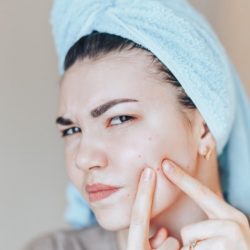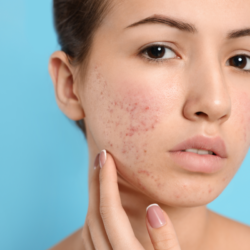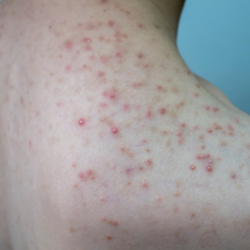If you’re looking for an effective treatment to smooth, brighten and renew your skin, you’ve probably heard of glycolic acid. This ultra-popular chemical exfoliant works wonders to improve skin texture, prevent the signs of ageing and combat imperfections. But how do you use it correctly and incorporate it safely into your beauty routine?
In this article, I explain everything you need to know about this AHA (alpha hydroxy acid) derived from sugar cane, its benefits, its effects on acne and skin ageing, and the precautions you need to take to get the most out of its exfoliating and moisturising properties.
What is glycolic acid?
This acid is an ingredient used in many cosmetics. Derived from sugar cane, it exfoliates the skin by accelerating cell renewal. In fact, it’s the most popular exfoliant of the moment! Its mechanism of action is as follows: It penetrates the skin’s pores to eliminate excess sebum and bacteria, thus facilitating collagen production.
Glycolic acid helps to clarify the complexion by smoothing the surface. In fact, it has the ability to dissolve the dead cells that accumulate on the skin’s surface, making it easier for the skincare products we use every day to penetrate (a guaranteed hydration boost!). This AHA can be found in many cosmetic products, particularly on the shelves of our online parapharmacy.
Is glycolic acid a good anti-ageing treatment for the body?
It is often considered an excellent anti-ageing product for the face because of its ability to stimulate the production of collagen and elastin in the skin, which can help reduce the appearance of fine lines and firm the skin. But what about its use on the body?
Using glycolic acid on the body can also help reduce the signs of ageing. As with the face, glycolic acid can help stimulate the production of collagen and elastin in the skin of the body, helping to improve skin texture and firmness. Glycolic acid can also help reduce the appearance of brown spots and other types of pigmentation on the body. By removing dead skin cells that contain melanin, glycolic acid can help even out skin tone.
However, it’s important to note that skin on the body is often thicker and more resistant than skin on the face, so it’s important to use higher concentrations of glycolic acid to achieve the same results. It is also important to follow the instructions for use with care and to test on a small area of skin before using glycolic acid on a larger surface.
Is glycolic acid an effective anti-acne ally?
If you’re fed up with blemishes that keep coming back, glycolic acid could well become your best ally! By eliminating the dead cells and excess sebum that clog pores, this chemical exfoliant prevents the proliferation of pimple-causing bacteria.
With regular use (1 to 2 times a week), it prevents the appearance of new blackheads and refines skin texture. The result? Fewer blackheads, fewer breakouts and smoother, more radiant skin. A real game-changer in the fight against acne!
Glycolic acid against wrinkles: a well-kept secret?
We often talk about glycolic acid for its exfoliating effects, but did you know that it’s also an excellent anti-ageing ally? As well as ridding the skin of dead cells, this AHA acts deep down to stimulate the production of collagen and elastin.
Its little extra? It’s a natural humectant, which means it retains moisture in the epidermis. The result is plumper, smoother, more luminous skin. If you’re looking for an effective treatment to reduce wrinkles and fine lines, glycolic acid clearly deserves a place in your beauty routine!
How to use glycolic acid properly
Glycolic acid comes in many forms: toning lotions, serums, cleansers, peels and even pre-soaked cotton pads. But how do you incorporate it correctly into your routine without irritating your skin?
- Try it before you try it! Apply a small amount to the crease of your elbow and wait 24 hours to detect any allergic reaction.
- Start gently: one application a week is enough to begin with (Wednesday evening, for example). Increase gradually if your skin tolerates it well.
- Always moisturise after use: Glycolic acid exfoliates and boosts cell renewal, but it can also sensitise the skin. A good moisturiser will help restore the skin barrier.
- Remember sun protection: Like all chemical exfoliants, glycolic acid makes skin more sensitive to UV rays. Apply at least SPF 30 every morning to avoid any irritation or pigmentation spots.
A little extra advice? If your skin is sensitive, you need to protect your hydrolipidic film. Opt for lower concentrations and avoid combining it with other powerful exfoliants such as retinol.
Is glycolic acid more powerful than vitamin C?
Glycolic acid and vitamin C are two popular ingredients in skincare products because of their many benefits for the skin. But is one ingredient more powerful than the other?
First of all, it’s important to note that glycolic acid and vitamin C have different functions for the skin. Glycolic acid is an exfoliant that removes dead skin cells, improves skin texture and stimulates the production of collagen and elastin. Vitamin C, meanwhile, is an antioxidant that protects the skin from free radical damage and also stimulates collagen production. In terms of potency, there’s no clear answer. It all depends on what you’re looking for in your skincare routine. If you’re looking to improve skin texture and reduce the signs of ageing, glycolic acid may be more effective. If you’re looking to protect your skin from free radical damage and stimulate collagen production, vitamin C may be more effective.
It’s also important to note that products containing glycolic acid and vitamin C can be used together in the same skincare routine. However, it is important to follow the order of application and start with the glycolic acid, followed by the vitamin C.
In conclusion, glycolic acid and vitamin C are both powerful ingredients for the skin, but their effectiveness depends on what you’re looking for in your skincare routine. It’s also possible to use them together, but it’s important to follow the order of application and be careful if you have sensitive skin.
What is a chemical exfoliant?
Glycolic acid belongs to the family of chemical exfoliants. Unlike “physical” exfoliants such as coffee or sea salt, and microbeads: products that require a “mechanical” action, a rotating movement of the hand, for the product to lift dead cells and other impurities from the surface of the skin.
Chemical exfoliants are able to dissolve the cement that holds the dead cells to the skin’s surface. What’s more, unlike grainy scrubs, they work from the inside out, dissolving residues of sebum, dirt and bacteria.
Read more:
- https://www.ncbi.nlm.nih.gov/pmc/articles/PMC6017965/
- https://www.ncbi.nlm.nih.gov/pmc/articles/PMC4720453/
- https://www.ncbi.nlm.nih.gov/pmc/articles/PMC3047947/





